How to Increase Boiler Pressure
A loss of boiler pressure could be the reason why your home takes a long time to warm up, why your energy bills have increased, or even why your boiler has stopped working. Increasing boiler pressure could solve these problems and is a job you can do without calling out an engineer. Read on to find out how to increase boiler pressure.
Last updated - 07/10/2022
Estimated reading time - 9 minutes
What is boiler pressure?
Boiler pressure is the pressure at which water circulates through your central heating system.
Maintaining your boiler’s optimum pressure is important in order to efficiently supply your home with heating and hot water.
If the boiler pressure is too high, there is a chance of leaks developing within your central heating system. If your boiler pressure is too low, your radiators and hot water might take longer to heat up, and your boiler will have to work harder to supply the central heating system with water, resulting in unnecessarily high energy bills!
What should my boiler pressure be?
Your boiler pressure will vary depending on whether your boiler is in use or not, but should be between 1 and 2 bar.
When in use
When your boiler is in use, the water in the system heats up and expands, causing the boiler pressure to increase, but it should not go above 2 bar.
When not in use
When your boiler is not in use, the pressure should be between 1 and 1.5 bar. If the pressure is below 1 bar, your boiler may not work and it will probably display an error code telling you to top up the pressure.
How do I check my boiler pressure?
Before knowing how to increase boiler pressure, you first need to know how to check your boiler pressure.
If you have a combination or system boiler, you will be able to see its boiler pressure on its pressure gauge. The pressure gauge indicates the current level of boiler pressure and is measured in bars.
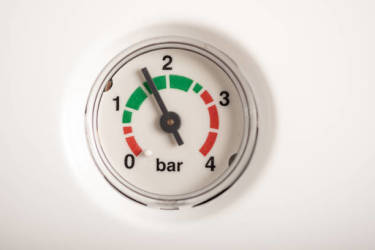
The location of your boiler’s pressure gauge will vary depending on the make and model of your boiler, but will most likely be on the front of your boiler. If your boiler has a front panel, the pressure gauge will probably be underneath it. Some older boilers have a pressure gauge on their underside.
Refer to your boiler’s manual to find the exact location of your boiler’s pressure gauge.
If you have a regular (heat-only) boiler, you will not need to repressurise it. Regular boilers use a feed and expansion tank to maintain a consistent level of water and pressure in the heating system.
How will I know if my boiler pressure is too low?
- Your radiators are not warming up properly
- There is no heating or hot water
- The needle on the pressure gauge has dropped below 1 bar
- Your boiler is showing fault code that relates to low pressure
Why is my boiler pressure too low?
Low boiler pressure is a common problem with most boiler systems. Your boiler pressure may be low for a number of different reasons. Here are a few of the most common:
You haven’t turned your central heating on for a while
If you haven’t used your central heating for a long time, like during the warm summer months, or if you have been away on holiday for a while, your boiler may have simply lost pressure because it hasn’t been used.
When your boiler is in use, pressure circulates water through the system. If your boiler is idle for a long period of time, water will not circulate through the system and the pressure will drop.
If you haven’t used your boiler for a while, turning on the central heating will get some hot water circulating through the system, which should increase your boiler pressure.
You have recently bled your radiators
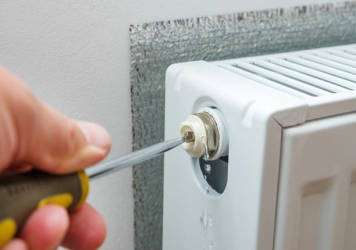
If you have recently bled your radiators, then water and trapped air have been released from the system, resulting in your boiler pressure dropping. The released air will need to be replaced with water in order to get the pressure back up.
You can find out how to do this further down in this article
There is a leak somewhere in the system
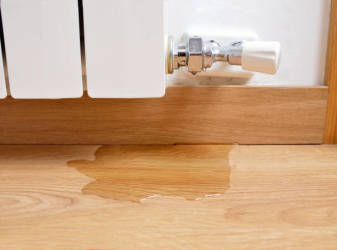
A leak in your central heating system will reduce the amount of water flowing through it and will result in a loss of pressure.
Leaks in a central heating system most commonly occur around the pipework connected to your radiators. If you see puddles of water or other signs of moisture underneath pipework or around radiators, then this could be a sign of a leak.
If there is a leak in your system, you will need a plumber to repair it.
Too much pressure in the system
It may be surprising but low boiler pressure can also be caused by the pressure in the system being too high.
Your boiler system will have a pressure relief valve. The pressure relief valve opens and closes to prevent a build-up of pressure. If the pressure level is too high, the valve will open to release some pressure and then close again once the pressure has dropped back down to a safe level.
If the pressure in the system is a little high when the boiler isn’t in use, turning on the boiler will further increase the pressure within the system, which will result in the pressure relief valve releasing water to relieve some pressure. When the boiler is not in use anymore, the pressure will drop again, which could cause the pressure to be lower than what it should be.
This is why whenever you top up your boiler pressure, you should not repressurise it above the recommended pressure level of 1 bar.
Faulty components
If any of the above isn’t the cause of your low boiler pressure, you may have a fault such as a damaged pressure relief valve, pump, expansion vessel, a problem with air vents, or another issue inside the boiler that can only be diagnosed and fixed by a trained boiler engineer.
Let us fix your boiler.
At Smart Plan we have thousands of engineers up and down the country who are ready to fix your issue. We guarantee an engineer to your property within 48 hours.
How to increase boiler pressure
The following methods are general guidelines on how to increase boiler pressure. Different types of boilers and different boiler manufacturers and models may have different methods of increasing boiler pressure. To find out in more detail how to increase boiler pressure on your specific boiler, refer to its manual.
The main way to increase boiler pressure is by using the filling loop. A filling loop is a small pipe or hose that is used to allow water from the mains to enter your boiler system to increase the pressure.
Internal filling loop
If you have a combi boiler, you will more than likely have an internal filling loop. Internal filling loops are filling loops that are integrated into the boiler system to make it easier for homeowners to repressurise their boilers.
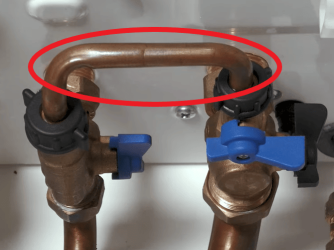
How to increase boiler pressure if your filling loop has a lever:
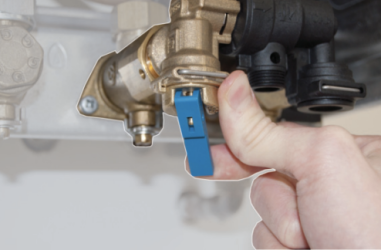
- Turn off your boiler and let it cool down.
- Locate the filling loop. It should be on the underside of the boiler.
- Pull the lever down. You should now hear water entering the central heating system.
- Keep an eye on the pressure gauge while holding the lever open.
- Let go of the lever once the needle on the pressure gauge has reaches 1 bar.
How to increase boiler pressure if your filling loop has taps:
- Turn off the boiler and allow it to cool.
- Locate the filling loop. It should be on the underside of the boiler.
- Make sure the filling loop is attached and secure.
- Turn both taps so that they are in line with the filling loop pipe (see image). You should now hear water flowing into the boiler system.
- While the taps are open, keep an eye on the pressure gauge.
- Turn off the taps once the needle has reached 1 bar. The taps are off when they are not in line with the filling loop pipe (see image).

Filling loop in closed position

How to increase boiler pressure if you have a keyed filling loop:
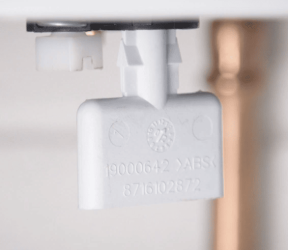
- Turn off the boiler and allow it to cool.
- Locate the filling loop key. It can usually be found on the concealed tray underneath the boiler or it may have been provided to you separately.
- On the underside of the boiler there will be an opening that the key fits into. Slot the key into the opening.
- Once the key is firmly inserted into the slot, turn the key. Water should be filling the system and the boiler pressure should now start to rise.
- Turn the key back to its original position once the needle on the pressure gauge reaches 1 bar.
- Remove the key and return it to where it was stored
External filling loop
If you have a system boiler you will have an external filling loop that is used to top up your boiler. An external filling loop is a braided hose that is often located near to where your system boiler’s hot water cylinder has been installed.
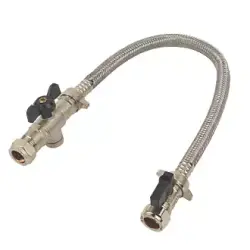
How to increase boiler pressure using an external filling loop:
- Turn off the boiler and allow it to cool.
- Locate the external filling loop. It should be located near the hot water cylinder.
- Turn one of the taps so that it runs in line with the filling loop (see image). If the external filling loop doesn’t have any taps, then it should have valves instead. Use a flat-head screwdriver to turn the valve so that it runs in line with the filling loop.
- Slowly turn the second tap or valve on the other side of the external filling loop until you hear water flowing.
- There should be a pressure gauge located near the cylinder and the external filling loop. Keep an eye on the pressure gauge and once it has reached 1 bar, turn the first tap or valve back to the off position (see image).
- Turn the tap or valve on the other side back to the off position.
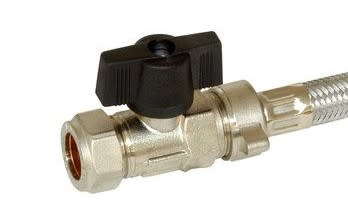

What should I do if I have over-pressurised my boiler?
If you have topped up your boiler pressure too much, you can reduce it by bleeding a radiator. Bleeding a radiator will release excess water and air from the central heating system and will lower the boiler pressure.
What should I do if my boiler pressure is still too low?
If you have taken the steps outlined in this article to increase your boiler pressure but your boiler pressure hasn’t increased or it needs topping up on a regular basis, there might be an issue with some boiler parts or there could be a leak somewhere in your central heating system. If this is the case, you will need to call a Gas Safe engineer to repair the issue. Ignoring boiler pressure issues could lead to bigger boiler problems.
Avoid unexpected costs.
With a Smart Plan cover policy, you can rest easy knowing if there's an issue with your boiler, we'll usually have you back up and running within 48 hours.

